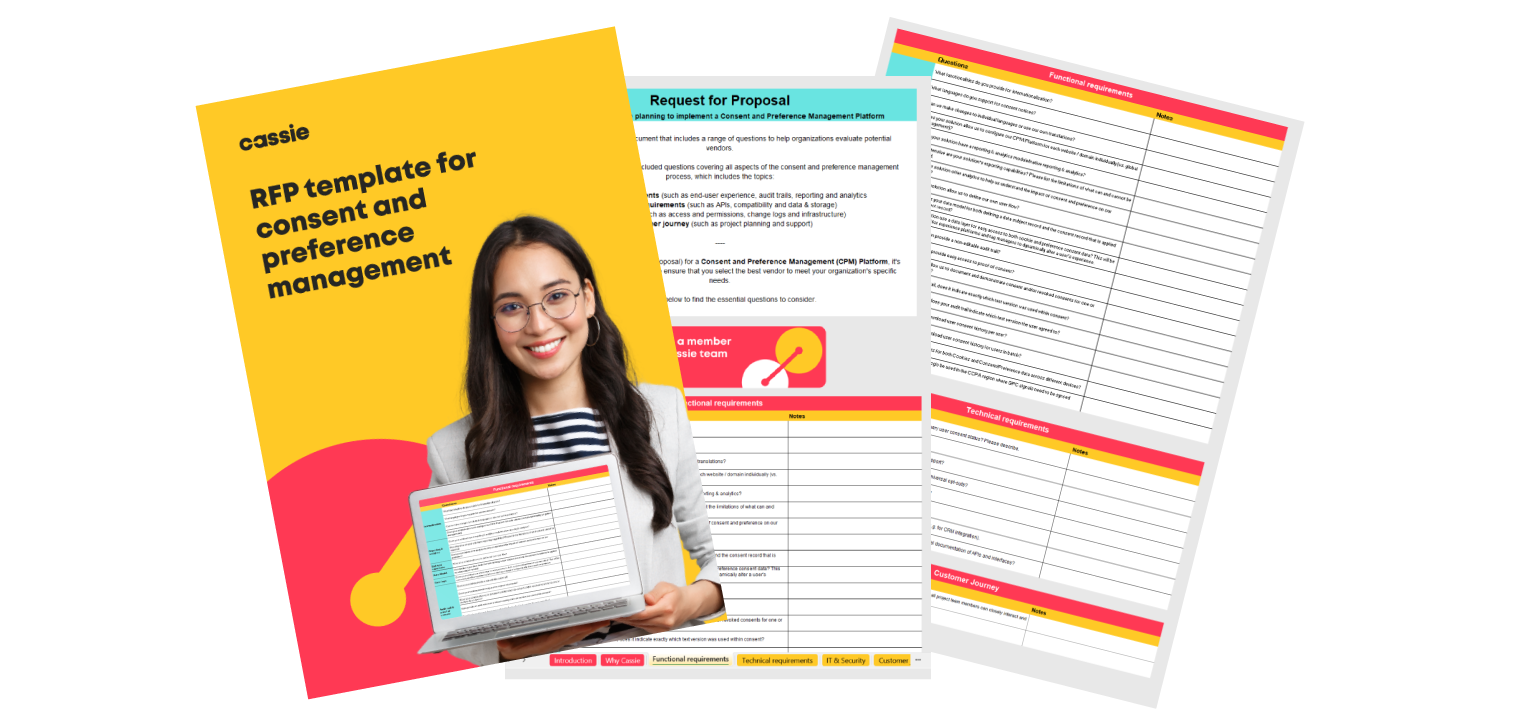A guide to getting stakeholder buy-in for your consent project
Posted: January 8, 2025
A project to establish a way to effectively collect, fulfil, and manage consents takes money, time, and cross functional resources. Whether the decision is to build or buy the consent management solution, the end result will most likely include a user interface, a mechanism to identify users, inter-system two-way communication, a system of truth for consent information, and a set of rules for applying consents in an appropriate (and sometimes complicated) way. The solution will need to track and report on compliance, as well as allow for trend analysis. Also, users will need training and on-going support to use and maintain the consent system. These components require input and support from professionals in vastly distinct roles across the company.
If the company decides to buy a ready-made solution rather than to build one from scratch, most or all the development burden is removed from the buying organization. However, even a company that buys a consent management platform will need to produce not only budget, but also agreement across the organization to support the process. This means that stakeholders across the organization will need to align and contribute to the success. Given the fact that a consent management solution involves so much of the organization – either as users, builders, or supporters – stakeholders will include privacy, legal, HR/training, information security, information technology, data science, marketing, sales, finance, and potentially other groups.
Obtaining buy-in across multiple stakeholder groups, which often have quite different motivations and reporting structures, can be a challenge. However, there are three useful steps to keep in mind in getting that buy-in.
- Involve stakeholders early (and often)
- Articulate the vision & value
- Define the process & roles
Involve stakeholders early (and often)
A key principle to change management is that change impacts a “diverse many” across the organization. Involving these stakeholders early and often is “your first step to moving change from something they feel they have to do to something they want to do.”
Bringing people along on the entire journey not only r increases buy-in along the way, but it also results in a solution that works for everyone. Stakeholders have a lot to contribute to early phases of any consent management project, including making the build-buy decision, building requirements, selecting a vendor (for a buy decision), and user acceptance testing of the result. As their ideas get incorporated and the value becomes even clearer, stakeholder buy-in will continue to deepen. Conversely, involving stakeholders late in the game will make inclusion of their ideas more difficult and lose out on the weeks or months they could have been advocates for the project.
For example, if the privacy office is leading the consent management effort, it might call together Marketing, Sales, IT/IS, Legal, Purchasing, Customer Support, and other stakeholders to socialize the vision of effort, get input, and build consensus. Then the privacy office might have one-on-one conversations with each group to socialize the benefits specific to each group, get alignment, and ask for support. Finally, the privacy office might hold regular meetings with all stakeholders to continue to build consensus, check on status, and confirm responsibilities through the end of the process and beyond. Throughout, stakeholders are more likely to be active and supportive, given that they helped build the process and contributed input from the beginning.
Articulate the vision & value
To become excited about consent management, stakeholders also must become aware of the benefits – not only to the organization, but also to their own smaller parts of the business. Fortunately, consent management has wide-reaching advantages that are easy to communicate. That said, the best way to create stakeholder buy-in is to be intentional about communicating the organizational vision of the future that consent management allows, and how each individual stakeholder group will specifically benefit.
For example, the marketing department may see a better return on marketing dollars and more flexibility with data, since there will be more confidence in what data they can use for which purposes. Legal and Compliance will see the risk of non-compliance reduced and increased ability to demonstrate compliance. IT/IS may benefit from enhanced security and efficiency benefits with a clear system of truth for consents and preferences. Regardless of the groups and benefits, taking the time to clearly articulate the organization’s vision for the future, how the consent management system will pave the way for that future, and how each stakeholder group will individually benefit is time well spent.
Define the process and stakeholder roles
Building requirements, selecting or building a solution, deploying, training, using, and monitoring a consent management system can be a time-consuming process with many moving parts. Stakeholders may find it difficult to maintain enthusiasm through the process without a clear understanding of what to expect, where they are in the process, and what role they will expect to play at each step. In fact, getting stakeholder input in building the process and defining roles in the process will both enhance stakeholder participation and result in a better process overall.
Touching base regularly about the process and status, along with expectations for each stakeholder group, will keep stakeholders engaged, informed, and able to plan for and fulfil their tasks.
This is also where strong visuals can help build clarity. Some organizations even build dashboards to demonstrate process, status, and activities/responsibilities. Whether weekly status meetings, emailed status PowerPoint decks or short video updates, or real-time dashboards, a clear process with regular updates will help create and maintain stakeholder buy-in over the lifespan of the consent management project.
One important stakeholder role that is essential to declare is the owner. In some cases, the owner may be a cross functional committee (made up of representation from all stakeholder groups) rather than a department. Regardless of whether the owner is Privacy, Marketing, IT/IS, or another group or committee, the owner must be clear for stakeholders to accomplish tasks.
In summary, cross functional stakeholder buy-in is essential for consent management projects. Getting and maintaining stakeholder buy-in can be challenging given different motivations and busy schedules – but it is possible with some forward-looking planning. Asking for input and help early, articulating company vision and individual stakeholder benefits, and defining/following a clear process with regular updates and stakeholder involvement will go a long way towards success.


